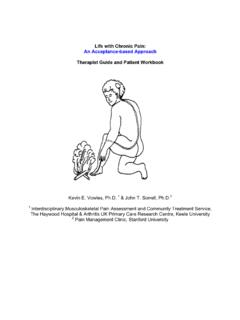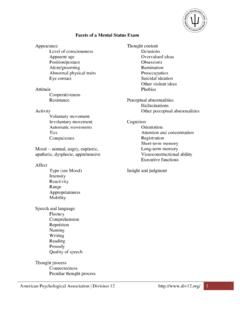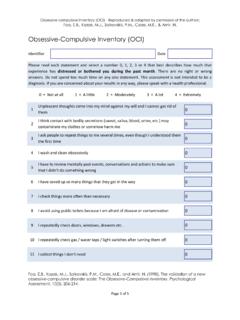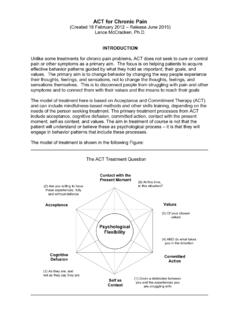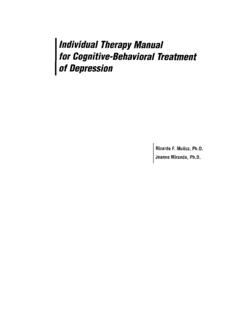Transcription of Comprehensive Cognitive Behavior Therapy for Social Phobia ...
1 Comprehensive Cognitive Behavior Therapy for Social Phobia : A treatment manual March 2005. Deborah Roth Ledley Edna B. Foa Jonathan D. Huppert In consultation with David M. Clark Revised Jan 2006 by Huppert (With subsequent modifications by James D. Herbert, Evan M. Forman, and Erica Yuen, September, 2009). 1. Summary of Modifications to the Ledley, Foa, & Huppert Comprehensive CT for SAD manual James D. Herbert, Evan M. Forman, & Erica Yuen September, 2009. Introduction 1. In notes, clarified that manual is designed for comorbid SAD and depression, if applicable. 2. Changed program from 16 to 12 weeks, and from hours to 1 hour sessions, with the exception that the first two sessions remain at 90 min. 3. Condensed sessions 2 & 3 into a single session (Session 2) 4. Exposure exercises begin in session 3 instead of 4. 5. Note that all sessions beginning at session 3 include at least one exposure (rather than most sessions ) 6.
2 Relapse prevention (sessions 15 and 16) is condensed to session 12. 7. Rather than allowing for 2 additional sessions (as needed) to focus on depression, instead the total treatment duration remains at 12 sessions, but therapists are permitted to delay implementation of the Social Phobia specific intervention in order to allow for an initial focus on behavioral activation, if necessary. 8. Deleted study- specific instructions ( , videotaping, specific measures, etc.). Throughout the manual 1. Modified the language to be more gender neutral ( , his his or her ). 2. Corrected typos, grammatical errors, and formatting inconsistencies. Session 1. 1. Changed the specific time frames, given the shorter duration of each session. 2. Noted that the specific references to depression should only be used as relevant, , for patients with significant depressive symptoms.
3 3. A few principles that highlight the Cognitive aspect of treatment were underlined, in order to draw specific attention to this focus. 4. In the original manual , the session concluded with noting that there would be 3 HW tasks, but yet only two were described. This was therefore changed to read two HW assignments. Session 2. 1. Condensed original sessions 2 and 3 into session 2. 2. Deleted development of fear hierarchy, as this will already have been done. 3. De- emphasized the amount of time devoted to reviewing the model at the beginning of the session. 2. 4. Underlined key procedures in the safety Behavior and video feedback exercise. 5. Noted that each exercise ( , conversation) should last approximately 5 minutes. 6. Deleted the rating of anticipated self- consciousness, as this is likely to be interpreted similarly as the rating of anxiety.
4 This was also deleted in order to save time and streamline the procedure. 7. The timing of the confederate making ratings of the patient's anxiety and performance during the safety Behavior experiment was modified. Rather than the confederate providing ratings to the therapist following the end of session 2, the confederate provides the ratings directly to the therapist immediately following each exercise. The therapist will then decide if and how to utilize these ratings. 8. Homework assignments for the original sessions 2 and 3 are combined into the revised session 2. Sessions 3-12. 1. It was noted that the in vivo exposures can be both simulated and unsimulated. 2. Language about these sessions being unstructured was modified to note that they are more flexible than the first two sessions, but still structured. In particular, it was noted that except in the most unusual circumstances ( crisis, sudden significant worsening of depressive symptoms), exposure exercises should be conducted in each session, and in fact are the focal point of each session in this phase.
5 3. It was emphasized that confederates, rather than the therapist, are typically employed in exposure exercises, increasingly over the course of treatment . 4. (p. 41) Formal Cognitive restructuring, derived from the Heimberg model, was introduced in the discussion of in vivo exposure exercises. 5. Re. the optional modules, it was noted that such modules should not replace in vivo exposures, but rather should be integrated with them as indicated. 6. In the discussion of the general structure of sessions, caveats about keeping this discussion brief and focused was added, as well as the importance of the therapist being aware of patients' tendencies to extend this discussion as a subtle form of avoidance of anxiety provoking exposure exercises. 7. Homework assignments were modified to include two new forms: the Attention and Safety Behaviors Monitoring Form and the Cognitive Self- Monitoring Form.
6 In vivo exposure module 1. Formal Cognitive restructuring (from the Heimberg model) was integrated into the description of exposure exercises throughout this module. Social skills and Assertiveness modules were unchanged (other than correcting typos, etc.). Termination module 1. The treatment length was changed from 16 to 12 sessions. 3. 4. Table of Contents List of Forms to Accompany manual .. 6 Notes on Use of the 7 Session One .. 10 Session Two .. 22 Therapist Notes .. 23 Sessions Three to 12 ( Social Phobia Modules).. 44 In vivo exposure Module .. 54 Imaginal exposure .. 64 Social Skills Training .. 67 Assertiveness Training .. 72 Preparing for the End of treatment .. 79 Setting the Framework for treatment .. 81 Forms .. 82 5. List of Forms to Accompany manual Form 1 page 74 Record of Weekly Self-Report Measures Form 2 page 75 Blank Model of Social Phobia Form 3 page 76 Annotated Model of Social Phobia Form 4 page 77 Questions about Your Social Anxiety Form 5 page 78 Technique Record and Progress Note Form 6 page 79 Safety Behaviors Experiment and Video Feedback Form 7 page 83 SUDS Scale Form 8 page 84 Hierarchy of Feared Social Situations Form 9 page 85 Worksheet for Exposures Form 10 page 87 Record Sheet for In-Session Imaginal Exposures Form 11 page 88 Record Sheet for Homework Imaginal Exposures Form 12 page 89 Goal Setting Worksheet Form 13 page 90 Social Behavior Questionnaire Form 14 page 91 List of Cognitive Distortions Form 15 page 94 Key Questions for Socratic Questioning Form 16 page 101 Cognitive Self-Monitoring Form Form 17 page 102
7 Attention and Safety Behaviors Monitoring Form 6. Notes on Use of the manual This manual outlines a treatment program designed for patients with Social Phobia . The program includes 12 weekly sessions of individual treatment , each lasting approximately 1 hour. Overview of CCBT. The treatment described in this manual places primary focus on Social Phobia ; it is appropriate for treating patients with Social Phobia and secondary comorbidities. The treatment program is flexible, allowing therapists to tailor treatment according to the idiosyncratic presentation of Social Phobia symptoms for each patient. In Session One, the treatment program begins with the therapist and patient deriving a model for the patient's Social Phobia , using Form 2. By illuminating the importance of focus of attention and safety behaviors in maintaining Social Phobia , the model serves as a guide for treatment .
8 At the end of the first session, activity monitoring is introduced (Form 4) and is assigned as homework. Session Two consists of the safety behaviors experiment and video feedback. The purpose of this experiment is to demonstrate to the patient, in an experiential way, the detrimental impact of self-focused attention and the use of safety behaviors, and that the patient's belief/experience about the way that he/she comes across to others is significantly different from reality (based on video feedback and confederate feedback). For Session Three and beyond, treatment consists of exposures, as well as other treatment techniques (video feedback, surveys, imaginal exposure, Social skills training, and assertiveness training) that are used on an as needed basis. All sessions beginning with session 3 include at least one in vivo exposure exercise ( , conversation with one or more 7.)
9 Confederates or going into public places to ask questions, etc.), and in vivo exposures are also assigned each week for homework. Accordingly, the patient has repeated opportunities to practice shifting focus of attention and dropping safety behaviors, thereby gathering evidence regarding exaggerated probability and cost judgments in the feared Social situations. The manual includes guidelines for when to make use of the optional modules (imaginal exposure, Social skills training, and assertiveness training) as a complement to ongoing in vivo exposure work. In Session 12, treatment concludes with a discussion of relapse prevention and with the therapist helping their patients to set specific goals for the year following treatment . This is meant to help the patient to be his/her own therapist once formal treatment ends. In some cases, secondary symptoms ( , depression) are so severe that it will be difficult to move on with Social anxiety treatment in Session 3.
10 For such patients, one can split the focus of sessions between Social Phobia and secondary symptoms. The main goal of such work is to get patients to the point that they are able to carry through with the treatment program. Examples would include behavioral activation to decrease depression and Cognitive restructuring aimed at increasing patients' motivation for the treatment and confidence in their ability to make positive changes in their lives. Such modification is only conducted when absolutely necessary, and would occur prior to the safety Behavior and video feedback exercise scheduled in session 2. While shifting focus back to Social Phobia treatment might seem difficult with these patients, moving on to the safety behaviors experiment can be helpful with both their mood and Social anxiety. Doing something in service of the Social anxiety can be experienced quite positively by patients and in most cases, they come away from the safety behaviors experiment with a sense of hope and with a 8.

